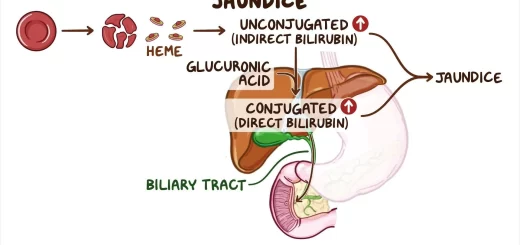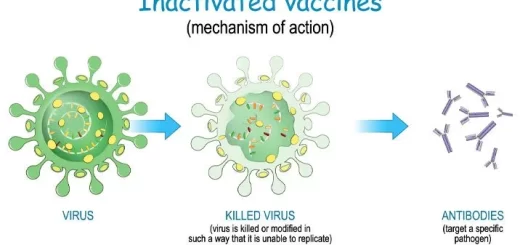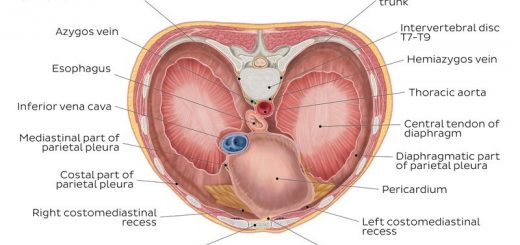Thoracic vertebrae structure, function, Chest wall muscles and Intercostal arteries
Human thoracic vertebrae are located in the thorax posterior and medial to the ribs, They are twelve bones that form the vertebral spine in the upper trunk, They support ribs, they support the weight of the upper body, they protect the delicate spinal cord because it runs through the vertebral canal. Thoracic vertebrae compose the middle segment of the vertebral column, between the cervical vertebrae and the lumbar vertebrae.
Thoracic vertebrae
Human thoracic vertebrae are strong bones, they are located in the middle of the vertebral column, sandwiched between the cervical ones above and the lumbar vertebrae below, they are separated by intervertebral discs. However, they are various anatomical features that make them quite distinct compared to other groups of vertebrae. Thoracic vertebrae are intermediate in size between the cervical and lumbar vertebrae.
Classification of thoracic vertebrae
There are twelve thoracic vertebrae classified as:
- Typical …………. … 2nd – 8th vertebrae.
- Atypical ……………. 1st, 9th, 10th, 11th, and 12th vertebrae. (first one and last 4 vertebrae).
Characteristics of a typical thoracic vertebra
- The body is characterized by: small in size and heart-shaped. Its side contains two demifacets: Large upper demifacet for articulation with the head of the rib of the corresponding number. Small lower demifacet for articulation with the head of the rib below it.
- The tip of the transverse process contains a circular facet for articulation with the tubercle of the rib of the corresponding number.
- The spine is long, tapering, and directed downwards and backwards.
- The vertebral foramen is circular and small.
- The superior articular facets face backwards, while the inferior articular facet face anteriorly.
Atypical thoracic vertebra
First thoracic vertebra:
- The body is small.
- The vertebral foramen is wide and triangular.
- The body carries a complete circular articular facet for articulation with the head of the first rib.
- The spine is horizontal.
The ninth & tenth thoracic vertebra:
- The ninth contains a superior demifacet and no inferior demifacet on the body.
- The tenth contains a complete superior facet and no inferior demifacet on the body.
The eleventh and twelveth thoracic vertebra:
- They contain one circular facet on the body.
- The inferior articular facet of the twelveth is directed anterolateral like the lumbar vertebrae.
The intercostal space contains:
- Intercostal muscles.
- Intercostal nerves.
- Intercostal arteries.
- Intercostal veins.
Intercostal muscles
They are arranged in three layers:
- Outer layer: which contains external intercostal muscle (directed obliquely downwards and forwards).
- Intermediate layer: which contains internal intercostal muscle (directed obliquely downwards and backwards).
- Inner layer: which contains:
- Innermost intercostal laterally (directed obliquely downwards and backwards).
- Sterno-costalis anteriorly.
- Sub-costalis posteriorly.
Chest wall muscles
External intercostals
From the sharp edge of above – downwards/forwards to rounded edges of rib below, from superior costotransverse ligament posteriorly to costochondral junction anteriorly. Then anterior intercostal membrane beyond this.
Internal intercostals
From costal groove above – downwards/forwards to the upper border of rib below, from sternal edge to angle of rib. The posterior intercostal membrane beyond this.
Transversus thoracis
- At back: Subcostals. In the lower chest. Wider below.
- At side: Innermost intercostals. Extend for more than one space.
- At front: Transversus thoracis (previously sternocostalis) form lower sternum to costal cartilages 2 – 6.
Intercostal arteries
They are divided into two groups:
- Anterior intercostal arteries: Each anterior intercostal space contains two anterior intercostal arteries (except in the lower two inter-costal spaces 10th & 11th space). The upper 6 pairs arise from the internal thoracic artery. The 7th, 8th, and 9th pairs arise from the musculo-phrenic artery.
- Internal thoracic (mammary) artery: Origin is from the first part of the subclavian artery. Termination is opposite the sixth intercostal space by dividing into superior epigastric and musculo-phrenic arteries.
Branches:
- Pericardial branches.
- Pericardiaco-phrenic artery.
- Mediastinal branches.
- Sternal branches.
- Perforating branches for the mammary gland.
- Anterior intercostal arteries (upper 6 spaces).
- Superior epigastric artery.
- Musculo-phrenic artery.
Internal thoracic (mammary) vein:
It is formed by the union of the two venae comitantes of the internal thoracic artery behind the third costal cartilage. It ascends close to the artery to terminate in the corresponding innominate vein.
Posterior intercostal arteries:
Each posterior intercostal space contains one posterior intercostal artery which runs in the costal groove. Each artery gives a collateral branch that runs over the upper border of the rip below.
The upper two posterior intercostal arteries arise from the superior intercostal artery (from the costo-cervical trunk) 2nd part of the subclavian artery. From 3 – 11 posterior intercostal arteries and subcostal artery arise from the descending thoracic aorta.
Anterior intercostal veins
- 2 in each space.
- 9th, 8th & 7th join the venae commitantes of musculo-phrenic artery.
- 6th, 5th & 4th join venae commitantes of internal mammary artery.
- 3rd, 2nd & 1st join internal mammary vein.
- Internal mammary vein drains into innominate (brachiocephalic vein).
Posterior intercostal arteries
- One in each of the 11 spaces
- 1st & 2nd arise from the superior intercostal artery of the costocervical trunk of the 2nd part of the subclavian artery.
- The lower 9 arteries & subcostal artery arise from descending thoracic aorta.
Intercostal veins
- Anterior intercostal veins: They correspond to the anterior intercostal arteries. They drain into the venae comitantes of the musculophrenic and internal thoracic arteries.
- Posterior intercostal veins: Differ on both sides of the body.
Right side:
- 1st post. intercostal vein into right innominate vein.
- 2nd + 3rd post. intercostal veins unite to form the right superior intercostal veinà Azygos vein.
- 4th – 11th post. intercostal veins into the azygos vein.
- Subcostal vein into the azygos vein.
Left side:
- 1st post. intercostal veinà left innominate vein.
- 2nd + 3rd post. intercostal veins unite to form the superior intercostal vein into the left innominate vein.
Intercostal nerves
There are 11 intercostal nerves in the upper 11 intercostal spaces and a subcostal nerve below the last rib (on each side). Each intercostal nerve arises from the ventral ramus of the corresponding thoracic nerve. They are classified into:
- Typical intercostal nerves (3-6).
- Atypical intercostal nerves: which are the first intercostal nerve, the second intercostal nerve, and the lower five intercostal nerves.
Typical intercostal nerves
Course:
Each nerve comes out from the intervertebral foramen and runs in the corresponding intercostal space. It passes between the posterior intercostal membrane and pleura. Then, it passes between the internal and innermost intercostal muscles. It passes anterior to sternocostalis and internal thoracic muscle. Then, it pierces the internal intercostal muscle and anterior intercostals membrane to end as an anterior cutaneous branch.
Branches:
- Communicating branch to the sympathetic trunk.
- The collateral branch which runs over the upper border of the rib below to supply the intercostal muscles.
- Anterior cutaneous branch.
- Lateral cutaneous branch which divides into anterior and posterior branches.
- Muscular branches to the intercostal muscles.
- Sensory branches to the pleura.
Atypical intercostal nerve
- The first intercostal nerve has a small lat. Cut. Branch to the axilla and ends as a small anterior cutaneous branch.
- Second intercostal nerve: Its lateral cutaneous branch is called the intercosto-branchial nerve which supplies the base of the axilla and upper part of the medial side of the arm and does not divide into anterior and posterior branches.
- Lower five intercostal nerves reach the anterior abdominal wall at the anterior ends of the spaces and supply its structures in addition to the diaphragm.
Arrangement of intercostal nerve and vessels in the costal groove
- In the posterior end of the space, the nerve is above the vessels.
- Then, it crosses behind the vessels to continue below them (VAN).
- In the posterior part, the vessels & nerves are midway between the two rips.
- In the lateral & anterior parts, in the costal groove.
Clinical points
Stap wounds in the posterior part of the intercostal spaces lead to injury of the posterior intercostal nerve and vessels because they run midway between the ribs. But in the lateral part of the intercostal spaces, they do not injure the posterior intercostal nerve and vessels because these structures are protected by the costal groove.
Heart function, structure, Valves, Borders, Chambers & Surfaces
Anatomy of the cardiovascular system, Thoracic cage function, structure & anatomy
Bones function, types & structure, The skeleton & Curvature of Spine in Adults
Bones of upper limb structure, function, types & anatomy
Interventricular septum, Blood supply, valves & Surface anatomy of the heart
Heart & Pericardium structure, Abnormalities & Development of the heart



